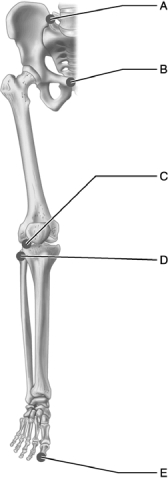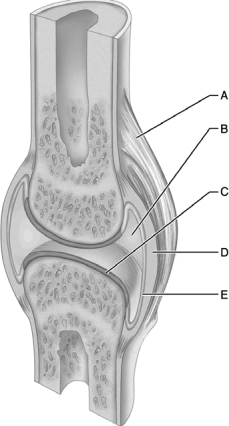Correct Answer

verified
Correct Answer
verified
True/False
One type of cartilage, fibrocartilage, characterizes all cartilaginous joints.
B) False
Correct Answer

verified
Correct Answer
verified
Multiple Choice
 Figure 9.2
Use the diagram above to answer the following questions.
-Which letter indicates an example of an interphalangeal joint?
Figure 9.2
Use the diagram above to answer the following questions.
-Which letter indicates an example of an interphalangeal joint?
A) A
B) B
C) C
D) D
E) E
G) A) and C)
Correct Answer

verified
Correct Answer
verified
Multiple Choice
An example of a diarthrotic synchondrosis
A) is the intertarsal joint.
B) is the epiphyseal plate.
C) is the knee.
D) does not exist.
F) A) and C)
Correct Answer

verified
Correct Answer
verified
True/False
A tendon sheath is an elongated membranous sac filled with synovial fluid that wraps around a tendon.
B) False
Correct Answer

verified
Correct Answer
verified
True/False
Hyaline cartilage forms many menisci, such as are found in the temporomandibular joint and the knee joint.
B) False
Correct Answer

verified
Correct Answer
verified
Multiple Choice
 Figure 9.2
Use the diagram above to answer the following questions.
-Which letter indicates the proximal articulation between the tibia and fibula and is a diarthrotic plane joint?
Figure 9.2
Use the diagram above to answer the following questions.
-Which letter indicates the proximal articulation between the tibia and fibula and is a diarthrotic plane joint?
A) A
B) B
C) C
D) D
E) E
G) A) and C)
Correct Answer

verified
Correct Answer
verified
True/False
Typical synovial joints are supplied by blood vessels and nerve fibers.
B) False
Correct Answer

verified
True
Correct Answer
verified
Multiple Choice
Capsular ligaments
A) are located outside the joint capsule.
B) are covered by synovial membrane.
C) are thickened parts of the joint capsule itself.
D) separate the synovial cavity into compartments.
F) A) and D)
Correct Answer

verified
Correct Answer
verified
Short Answer
This kind of joint is composed of very short connective tissue fibers that are continuous with the periosteum of the flat bone.
Correct Answer

verified
Correct Answer
verified
Multiple Choice
 Figure 9.1
Use the diagram above to answer the following questions.
-Which letter indicates the layer of the articular capsule that is the most highly vascularized?
Figure 9.1
Use the diagram above to answer the following questions.
-Which letter indicates the layer of the articular capsule that is the most highly vascularized?
A) A
B) B
C) C
D) D
E) E
G) C) and D)
Correct Answer

verified
Correct Answer
verified
Multiple Choice
 Figure 9.2
Use the diagram above to answer the following questions.
-Which letter indicates a cartilaginous, amphiarthrotic, symphysis type of joint?
Figure 9.2
Use the diagram above to answer the following questions.
-Which letter indicates a cartilaginous, amphiarthrotic, symphysis type of joint?
A) A
B) B
C) C
D) D
E) E
G) A) and B)
Correct Answer

verified
Correct Answer
verified
Essay
Describe the three types of fibrous joints, including examples of each.
Correct Answer

verified
Sutures are located between many of the bones of the skull, with fibers of the joint continuous with the periosteum of the adjacent bones. Syndesmoses are connected by long fibrous ligaments, such as those found at the distal tibiofibular articulation. Considerable motion is possible at these types of joints, even though there is no synovial capsule. Gomphoses are found between the roots of the teeth and the tooth sockets of the mandible and maxilla. The teeth are held in place with numerous, short periodontal ligaments.
Correct Answer
verified
Multiple Choice
All of the following can be performed at the wrist except
A) flexion and extension of the hand.
B) circumduction of the hand.
C) abduction and adduction of the hand.
D) rotation of the hand.
F) All of the above
Correct Answer

verified
Correct Answer
verified
Multiple Choice
 Figure 9.2
Use the diagram above to answer the following questions.
-Which letter on the diagram indicates a modified hinge joint?
Figure 9.2
Use the diagram above to answer the following questions.
-Which letter on the diagram indicates a modified hinge joint?
A) A
B) B
C) C
D) D
E) E
G) C) and E)
Correct Answer

verified
C
Correct Answer
verified
Multiple Choice
An example of a synarthrotic fibrous joint is the
A) interosseous membrane between the radius and the ulna.
B) intervertebral discs.
C) pubic symphysis.
D) sagittal suture.
F) B) and D)
Correct Answer

verified
Correct Answer
verified
Multiple Choice
When the fibrous tissue of sutures ossifies, the resulting joint is called a
A) synostosis.
B) syndesmosis.
C) symphysis.
D) synchondrosis.
F) A) and B)
Correct Answer

verified
Correct Answer
verified
Multiple Choice
In pronation,
A) the ulna rotates, but the radius does not.
B) the forearm is laterally rotated.
C) the palm faces anteriorly.
D) the radius and ulna are crossed.
F) A) and C)
Correct Answer

verified
Correct Answer
verified
Multiple Choice
 Figure 9.1
Use the diagram above to answer the following questions.
-Which letter indicates a ligament that connects bone to bone and is external to the joint capsule?
Figure 9.1
Use the diagram above to answer the following questions.
-Which letter indicates a ligament that connects bone to bone and is external to the joint capsule?
A) A
B) B
C) C
D) D
E) E
G) All of the above
Correct Answer

verified
Correct Answer
verified
Multiple Choice
Studentʹs elbow is an example of
A) osteoarthritis.
B) tendonitis.
C) bursitis.
D) gout.
F) A) and D)
Correct Answer

verified
Correct Answer
verified
Showing 1 - 20 of 110
Related Exams